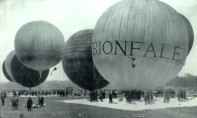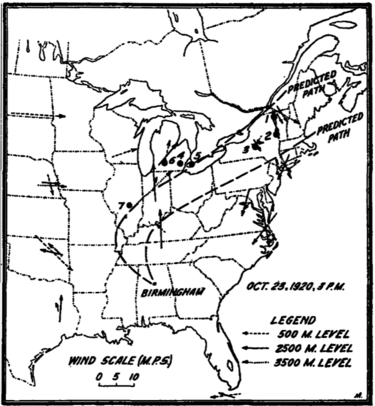1920 International Balloon Race
The 1920 International Balloon Race (held on October 23, 1920) was the ninth in an ongoing series of international balloon races initiated by James Gordon Bennett, Jr, publisher of the New York Herald, in 1906. The home country of each year's winning team has the honor of hosting the next event. The country that managed to win three consecutive races would take home the Gordon Bennett Cup.
In 1913, the team of Ralph Hazlett Upson and Ralph Albion Drury Preston, flying in the Goodyear won the trophy after a 618 kilometer, 43 hour, 30 minute flight from Paris. The subsequent races were prevented by World War I and Birmingham was selected as the launching site for the next contest, which took place in 1920. By that time the military usefulness of balloons, once highly esteemed, had been squelched by the dominance of airplanes.
This was the first of the international balloon races for which the pilots had the benefit of upper-air as well as surface weather reports, which were supplied by the Weather Bureau's Birmingham office.
The race featured seven competing balloons. Three from the United States, two from Italy, and one each from France and Belgium. The goal of the race was Labrador, but the winner would be whichever team accomplished the greatest distance along the path from Birmingham to Labrador. Landings at sea do not count. Germany and Austria were not allowed to participate.
The launch was made at 3:00 in the afternoon of October 23, with prevailing wind leading the competitors in a north-by-northwest direction from the city, and up the Mississippi Valley. The second night provided an opportunity when a swifter wind picked up the then-slowest group at high altitude and whisked them eastward back toward the intended course.
The winner, Belgian Ernest Demuyter, assisted by M. Labrousse, landed his balloon, Belgica at North Hero Island in Lake Champlain (Vermont/Canada) 40 hours and 15 minutes after the launch. Their winning distance was 1,769 km, the third longest in the race to that time. Most of the balloonists landed eventually, up to 8 hours after Demuyter had recorded his victory, in the vicinity of the Great Lakes. Harry E. Honeywell, one of the American balloonists, set a national endurance record with his 48 hour, 26 minute flight in the Uncle Sam. The Italians took the 3rd and 4th places, with Upson in 5th, followed by fellow American Thompson in 6th and Hischauer of France falling to last place with an estimated 800 km attained.
The publicity of this race led the Birmingham Aero Club to propose the 1921 National Balloon Race also be hosted in Birmingham, serving as a centerpiece to the Semicentennial celebrations. Demuyter, for his part, became a hero to war-stricken Belgium. The 1921 cup race from Brussels was a disappointing defeat, but he came back to win three straight from 1922-24, thereby claiming the Gordon Bennett Cup for Belgium in the 13th race of the series, at the helm of a new silk balloon bought by funds raised from readers of the Etoile Belge.
References
- International Ballooning Commission (n. d.) "The Ninth Gordon Bennett Race 1920" - accessed November 4, 2006
- Andrus, C. G. (January 1921) "Meteorological Aspects of the International Balloon Race of 1920". Monthly Weather Review. Vol. 49, Issue 1, pp. 8-10 - accessed November 4, 2006 (PDF)

